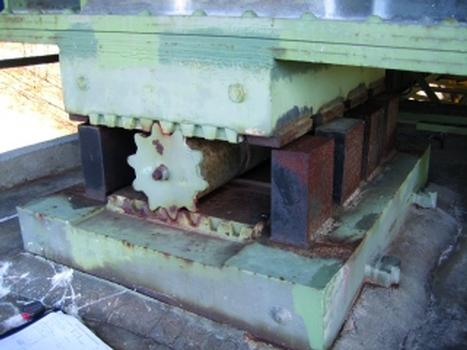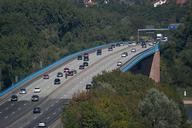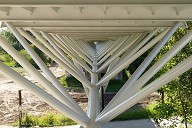Double Cylinder instead of Rolls
The Grenzwald Bridge was built between 1966 and 1968. The 900 m long bridge is located at the motorway A7 at the boundary between Bavaria and Hessen. The bridge has 10 bearing axes, with 2 bearings per axis. On the two central piers are four fixed bearings, and the 16 roller bearings had to be replaced because they reached their service life.
The roller bearings halve the movements of super structure and substructure, and this is of special importance at the Grenzwald Bridge with its spans of up to 120 m and piers of up to 95 m height. A second advantage is that the long rollers and the rectangular armour plates can accommodate relatively high loads. The disadvantages of roller bearings are well known: They are expensive. Moreover it is difficult to reduce the dimensions, because higher strength materials also display a higher likelihood of brittle failure.
Acceptance of a special solution
The bidding documents for the replacement of the roller bearings called for spherical bearings with a special sliding material. However, Maurer Söhne was awarded the tender with their special proposal of "Double cylindrical bearings". For this innovative design, only early 2010 the General Approval for Germany was awarded (AbZ Z-16.4-436). The new bearing type simulates a roller bearing in its displacements, geometry and rotation, is however considerably more economic, safer, and employs a longer service life. Thereby, the issue of displacement was a special hot one, because due to the new standardization for bearings, particularly high displacement values had to be assumed for the moving bearings.
Like the roller bearings, the new double cylindrical bearings have two movement surfaces – one above, one below. A third sliding surface lies in between in the shape of a bowl and accommodates the tilting movements.
In the section lateral to the direction of traffic, a cylindrical bearing looks like a spherical bearing. However, in the bowl does not rest a round calotte, but a cylinder which is separated along its length. Like with the roller bearing, the result is a rectangular foot print, and the bearing can be designed in correspondence with the load sufficiently wide. In contrast, for the load introduction, a spherical bearing is always confined to a quadratic or round foot print.
Like a roller bearing, the cylinder in the bowl only permits rotational movements around its cylindrical axis. By way of special patented stoppers the cylindrical bearing was ultimately built such that it corresponds both geometrically and functionally to a roller bearing. This way, roller bearings can be replaced without impacting the structure.
Long service life, low friction coefficients
All three sliding surfaces employ MSM®. The sliding material ensures that in spite of high accumulated displacements, for the new cylindrical bearings a service life of at least 50 years can be guaranteed. Additional advantages of the new sliding bearings are the lower friction coefficients, which come close to the rolling resistance of high strength roller bearings, as well as a certain (minimum) rotation along the cross axis.
Since October 2010, the 16 bearings are replaced one by one. The new double cylindrical bearings are lower than the old rollers with their armoured plates. The lower dimension in height is being compensated by grouting layers below and above
References
Structure Types
- About this
data sheet - Product-ID
3276 - Published on:
30/04/2012 - Last updated on:
19/05/2017



 MAURER SE
MAURER SE 


